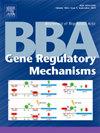Insights into the target-directed miRNA degradation mechanism in Drosophila ovarian cell culture
IF 3.1
3区 生物学
Q3 BIOCHEMISTRY & MOLECULAR BIOLOGY
Biochimica et Biophysica Acta-Gene Regulatory Mechanisms
Pub Date : 2025-05-04
DOI:10.1016/j.bbagrm.2025.195092
引用次数: 0
Abstract
Target-directed miRNA degradation (TDMD) is a process of post-transcriptional regulation of miRNA stability in animals induced by an extended pairing of Ago-bound miRNAs with specialized complementary RNA targets. As suggested by studies on human cell culture, Ago engaged with the extended duplex is recognized by the ZSWIM8 receptor of the Cullin-RING-ligase complex (CRL3), which also contains Cul3, EloB, and EloC proteins. The CRL activity is accelerated by the neddylation of Cul3 with the involvement of the E2 conjugating protein UbcE2M. The CRL ubiquitinates Ago, resulting in proteolysis of Ago and degradation of the released miRNAs. To date, the molecular mechanism of TDMD has not been studied in other species. To further characterize TDMD in animals, we investigated the protein Dora, the Drosophila ortholog of ZSWIM8, in the culture of Drosophila ovarian somatic cells (OSC). We showed that Dora in OSCs localizes in protein granules unrelated to P- and GW-bodies. The dora knockout resulted in the accumulation of multiple miRNAs, including miR-7-5p, and transcriptome-wide affected the mRNA targets of differentially expressed miRNAs. We also showed that Dora associates with proteins of the CRL3 complex, and the depletion of CRL3 components or inhibition of Cul3 neddylation upregulates miR-7-5p. We concluded that the molecular mechanism of TDMD is conserved in humans and Drosophila. Finally, we found that cells without Dora have an impaired Notch signaling pathway, indicating that TDMD in OSCs may contribute to the modulation of the Notch pathway.
果蝇卵巢细胞培养中靶向miRNA降解机制的研究
靶定向miRNA降解(Target-directed miRNA degradation, TDMD)是通过ago结合miRNA与特异性互补RNA靶标的扩展配对,诱导动物miRNA稳定性的转录后调控过程。人类细胞培养的研究表明,与扩展双工结合的Ago被Cullin-RING-ligase复合物(CRL3)的ZSWIM8受体识别,该复合物还含有Cul3、EloB和EloC蛋白。在E2偶联蛋白UbcE2M的参与下,Cul3的类化修饰加速了CRL的活性。CRL泛素化Ago,导致Ago的蛋白水解和释放的mirna的降解。迄今为止,尚未在其他物种中研究TDMD的分子机制。为了进一步表征动物中的TDMD,我们在果蝇卵巢体细胞(OSC)培养中研究了ZSWIM8的果蝇同源蛋白Dora。我们发现Dora在OSCs中定位于与P-和gw -体无关的蛋白质颗粒中。dora基因敲除导致包括miR-7-5p在内的多个mirna的积累,并且转录组范围内影响差异表达mirna的mRNA靶标。我们还发现Dora与CRL3复合体的蛋白相关,CRL3成分的缺失或Cul3类化修饰的抑制可上调miR-7-5p。我们认为TDMD的分子机制在人类和果蝇中是保守的。最后,我们发现没有Dora的细胞Notch信号通路受损,表明OSCs中的TDMD可能参与了Notch通路的调节。
本文章由计算机程序翻译,如有差异,请以英文原文为准。
求助全文
约1分钟内获得全文
求助全文
来源期刊
CiteScore
9.20
自引率
2.10%
发文量
63
审稿时长
44 days
期刊介绍:
BBA Gene Regulatory Mechanisms includes reports that describe novel insights into mechanisms of transcriptional, post-transcriptional and translational gene regulation. Special emphasis is placed on papers that identify epigenetic mechanisms of gene regulation, including chromatin, modification, and remodeling. This section also encompasses mechanistic studies of regulatory proteins and protein complexes; regulatory or mechanistic aspects of RNA processing; regulation of expression by small RNAs; genomic analysis of gene expression patterns; and modeling of gene regulatory pathways. Papers describing gene promoters, enhancers, silencers or other regulatory DNA regions must incorporate significant functions studies.

 求助内容:
求助内容: 应助结果提醒方式:
应助结果提醒方式:


